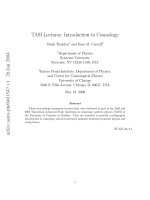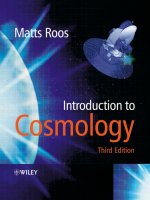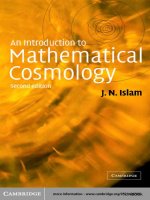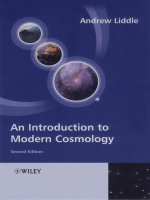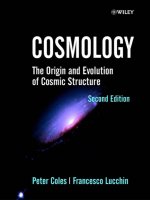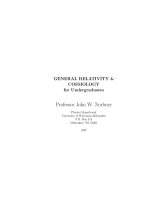Cosmology
Bạn đang xem bản rút gọn của tài liệu. Xem và tải ngay bản đầy đủ của tài liệu tại đây (155.85 KB, 15 trang )
December 1997 Lecture Notes on General Relativity Sean M. Carroll
8 Cosmology
Contemporary cosmological models are based on the idea that the universe is pretty much
the same everywhere — a stance sometimes known as the Copernican principle. On the
face of it, such a claim seems preposterous; the center of the sun, for example, bears little
resemblance to the desolate cold of interstellar space. But we take the Copernican principle
to only apply on the very largest scales, where local variations in density are averaged
over. Its validity on such scales is manifested in a number of different observations, such
as number counts of galaxies and observations of diffuse X-ray and γ-ray backgrounds, but
is most clear in the 3
◦
microwave background radiation. Although we now know that the
microwave background is not perfectly smooth (and nobody ever expected that it was), the
deviations from regularity are on the order of 10
−5
or less, certainly an adequate basis for
an approximate description of spacetime on large scales.
The Copernican principle is related to two more mathematically precise properties that
a manifold might have: isotropy and homogeneity. Isotropy applies at some specific point
in the space, and states that the space looks the same no matter what direction you look in.
More formally, a manifold M is isotropic around a point p if, for any two vectors V and W
in T
p
M, there is an isometry of M such that the pushforward of W under the isometry is
parallel with V (not pushed forward). It is isotropy which is indicated by the observations
of the microwave background.
Homogeneity is the statement that the metric is the same throughout the space. In
other words, given any two points p and q in M, there is an isometry which takes p into q.
Note that there is no necessary relationship between homogeneity and isotropy; a manifold
can be homogeneous but nowhere isotropic (such as R × S
2
in the usual metric), or it can
be isotropic around a point without being homogeneous (such as a cone, which is isotropic
around its vertex but certainly not homogeneous). On the other hand, if a space is isotropic
everywhere then it is homogeneous. (Likewise if it is isotropic around one point and also
homogeneous, it will be isotropic around every point.) Since there is ample observational
evidence for isotropy, and the Copernican principle would have us believe that we are not
the center of the universe and therefore observers elsewhere should also observe isotropy, we
will henceforth assume both homogeneity and isotropy.
There is one catch. When we look at distant galaxies, they appear to be receding from us;
the universe is apparently not static, but changing with time. Therefore we begin construc-
tion of cosmological models with the idea that the universe is homogeneous and isotropic in
space, but not in time. In general relativity this translates into the statement that the uni-
verse can be foliated into spacelike slices such that each slice is homogeneous and isotropic.
217
8 COSMOLOGY 218
We therefore consider our spacetime to be R × Σ, where R represents the time direction
and Σ is a homogeneous and isotropic three-manifold. The usefulness of homogeneity and
isotropy is that they imply that Σ must be a maximally symmetric space. (Think of isotropy
as invariance under rotations, and homogeneity as invariance under translations. Then ho-
mogeneity and isotropy together imply that a space has its maximum possible number of
Killing vectors.) Therefore we can take our metric to be of the form
ds
2
= −dt
2
+ a
2
(t)γ
ij
(u)du
i
du
j
. (8.1)
Here t is the timelike coordinate, and (u
1
, u
2
, u
3
) are the coordinates on Σ; γ
ij
is the max-
imally symmetric metric on Σ. This formula is a special case of (7.2), which we used to
derive the Schwarzschild metric, except we have scaled t such that g
tt
= −1. The function
a(t) is known as the scale factor, and it tells us “how big” the spacelike slice Σ is at the
moment t. The coordinates used here, in which the metric is free of cross terms dt du
i
and
the spacelike components are proportional to a single function of t, are known as comoving
coordinates, and an observer who stays at constant u
i
is also called “comoving”. Only
a comoving observer will think that the universe looks isotropic; in fact on Earth we are
not quite comoving, and as a result we see a dipole anisotropy in the cosmic microwave
background as a result of the conventional Doppler effect.
Our interest is therefore in maximally symmetric Euclidean three-metrics γ
ij
. We know
that maximally symmetric metrics obey
(3)
R
ijkl
= k(γ
ik
γ
jl
− γ
il
γ
jk
) , (8.2)
where k is some constant, and we put a superscript
(3)
on the Riemann tensor to remind us
that it is associated with the three-metric γ
ij
, not the metric of the entire spacetime. The
Ricci tensor is then
(3)
R
jl
= 2kγ
jl
. (8.3)
If the space is to be maximally symmetric, then it will certainly be spherically symmetric.
We already know something about spherically symmetric spaces from our exploration of the
Schwarzschild solution; the metric can be put in the form
dσ
2
= γ
ij
du
i
du
j
= e
2β(r)
dr
2
+ r
2
(dθ
2
+ sin
2
θ dφ
2
) . (8.4)
The components of the Ricci tensor for such a metric can be obtained from (7.16), the Ricci
tensor for a spherically symmetric spacetime, by setting α = 0 and ∂
0
β = 0, which gives
(3)
R
11
=
2
r
∂
1
β
(3)
R
22
= e
−2β
(r∂
1
β − 1) + 1
(3)
R
33
= [e
−2β
(r∂
1
β − 1) + 1] sin
2
θ . (8.5)
8 COSMOLOGY 219
We set these proportional to the metric using (8.3), and can solve for β(r):
β = −
1
2
ln(1 − kr
2
) . (8.6)
This gives us the following metric on spacetime:
ds
2
= −dt
2
+ a
2
(t)
dr
2
1 − kr
2
+ r
2
(dθ
2
+ sin
2
θ dφ
2
)
. (8.7)
This is the Robertson-Walker metric. We have not yet made use of Einstein’s equations;
those will determine the behavior of the scale factor a(t).
Note that the substitutions
k →
k
|k|
r →
|k| r
a →
a
√
|k|
(8.8)
leave (8.7) invariant. Therefore the only relevant parameter is k/|k|, and there are three
cases of interest: k = −1, k = 0, and k = +1. The k = −1 case corresponds to constant
negative curvature on Σ, and is called open; the k = 0 case corresponds to no curvature on
Σ, and is called flat; the k = +1 case corresponds to positive curvature on Σ, and is called
closed.
Let us examine each of these possibilities. For the flat case k = 0 the metric on Σ is
dσ
2
= dr
2
+ r
2
dΩ
2
= dx
2
+ dy
2
+ dz
2
, (8.9)
which is simply flat Euclidean space. Globally, it could describe R
3
or a more complicated
manifold, such as the three-torus S
1
× S
1
× S
1
. For the closed case k = +1 we can define
r = sin χ to write the metric on Σ as
dσ
2
= dχ
2
+ sin
2
χ dΩ
2
, (8.10)
which is the metric of a three-sphere. In this case the only possible global structure is
actually the three-sphere (except for the non-orientable manifold RP
3
). Finally in the open
k = −1 case we can set r = sinh ψ to obtain
dσ
2
= dψ
2
+ sinh
2
ψ dΩ
2
. (8.11)
This is the metric for a three-dimensional space of constant negative curvature; it is hard
to visualize, but think of the saddle example we spoke of in Section Three. Globally such
a space could extend forever (which is the origin of the word “open”), but it could also
8 COSMOLOGY 220
describe a non-simply-connected compact space (so “open” is really not the most accurate
description).
With the metric in hand, we can set about computing the connection coefficients and
curvature tensor. Setting ˙a ≡ da/dt, the Christoffel symbols are given by
Γ
0
11
=
a˙a
1 − kr
2
Γ
0
22
= a˙ar
2
Γ
0
33
= a˙ar
2
sin
2
θ
Γ
1
01
= Γ
1
10
= Γ
2
02
= Γ
2
20
= Γ
3
03
= Γ
3
30
=
˙a
a
Γ
1
22
= −r(1 − kr
2
) Γ
1
33
= −r(1 − kr
2
) sin
2
θ
Γ
2
12
= Γ
2
21
= Γ
3
13
= Γ
3
31
=
1
r
Γ
2
33
= − sin θ cos θ Γ
3
23
= Γ
3
32
= cot θ . (8.12)
The nonzero components of the Ricci tensor are
R
00
= −3
¨a
a
R
11
=
a¨a + 2 ˙a
2
+ 2k
1 − kr
2
R
22
= r
2
(a¨a + 2 ˙a
2
+ 2k)
R
33
= r
2
(a¨a + 2 ˙a
2
+ 2k) sin
2
θ , (8.13)
and the Ricci scalar is then
R =
6
a
2
(a¨a + ˙a
2
+ k) . (8.14)
The universe is not empty, so we are not interested in vacuum solutions to Einstein’s
equations. We will choose to model the matter and energy in the universe by a perfect
fluid. We discussed perfect fluids in Section One, where they were defined as fluids which
are isotropic in their rest frame. The energy-momentum tensor for a perfect fluid can be
written
T
µν
= (p + ρ)U
µ
U
ν
+ pg
µν
, (8.15)
where ρ and p are the energy density and pressure (respectively) as measured in the rest
frame, and U
µ
is the four-velocity of the fluid. It is clear that, if a fluid which is isotropic in
some frame leads to a metric which is isotropic in some frame, the two frames will coincide;
that is, the fluid will be at rest in comoving coordinates. The four-velocity is then
U
µ
= (1, 0, 0, 0) , (8.16)
and the energy-momentum tensor is
T
µν
=
ρ 0 0 0
0
0 g
ij
p
0
. (8.17)
8 COSMOLOGY 221
With one index raised this takes the more convenient form
T
µ
ν
= diag(−ρ, p, p, p) . (8.18)
Note that the trace is given by
T = T
µ
µ
= −ρ + 3p . (8.19)
Before plugging in to Einstein’s equations, it is educational to consider the zero compo-
nent of the conservation of energy equation:
0 = ∇
µ
T
µ
0
= ∂
µ
T
µ
0
+ Γ
µ
µ0
T
0
0
− Γ
λ
µ0
T
µ
λ
= −∂
0
ρ − 3
˙a
a
(ρ + p) . (8.20)
To make progress it is necessary to choose an equation of state, a relationship between ρ
and p. Essentially all of the perfect fluids relevant to cosmology obey the simple equation of
state
p = wρ , (8.21)
where w is a constant independent of time. The conservation of energy equation becomes
˙ρ
ρ
= −3(1 + w)
˙a
a
, (8.22)
which can be integrated to obtain
ρ ∝ a
−3(1+w)
. (8.23)
The two most popular examples of cosmological fluids are known as dust and radiation.
Dust is collisionless, nonrelativistic matter, which obeys w = 0. Examples include ordinary
stars and galaxies, for which the pressure is negligible in comparison with the energy density.
Dust is also known as “matter”, and universes whose energy density is mostly due to dust
are known as matter-dominated. The energy density in matter falls off as
ρ ∝ a
−3
. (8.24)
This is simply interpreted as the decrease in the number density of particles as the universe
expands. (For dust the energy density is dominated by the rest energy, which is proportional
to the number density.) “Radiation” may be used to describe either actual electromagnetic
radiation, or massive particles moving at relative velocities sufficiently close to the speed of
light that they become indistinguishable from photons (at least as far as their equation of
state is concerned). Although radiation is a perfect fluid and thus has an energy-momentum
8 COSMOLOGY 222
tensor given by (8.15), we also know that T
µν
can be expressed in terms of the field strength
as
T
µν
=
1
4π
(F
µλ
F
ν
λ
−
1
4
g
µν
F
λσ
F
λσ
) . (8.25)
The trace of this is given by
T
µ
µ
=
1
4π
F
µλ
F
µλ
−
1
4
(4)F
λσ
F
λσ
= 0 . (8.26)
But this must also equal (8.19), so the equation of state is
p =
1
3
ρ . (8.27)
A universe in which most of the energy density is in the form of radiation is known as
radiation-dominated. The energy density in radiation falls off as
ρ ∝ a
−4
. (8.28)
Thus, the energy density in radiation falls off slightly faster than that in matter; this is
because the number density of photons decreases in the same way as the number density of
nonrelativistic particles, but individual photons also lose energy as a
−1
as they redshift, as
we will see later. (Likewise, massive but relativistic particles will lose energy as they “slow
down” in comoving coordinates.) We believe that today the energy density of the universe
is dominated by matter, with ρ
mat
/ρ
rad
∼ 10
6
. However, in the past the universe was much
smaller, and the energy density in radiation would have dominated at very early times.
There is one other form of energy-momentum that is sometimes considered, namely that
of the vacuum itself. Introducing energy into the vacuum is equivalent to introducing a
cosmological constant. Einstein’s equations with a cosmological constant are
G
µν
= 8πGT
µν
− Λg
µν
, (8.29)
which is clearly the same form as the equations with no cosmological constant but an energy-
momentum tensor for the vacuum,
T
(vac)
µν
= −
Λ
8πG
g
µν
. (8.30)
This has the form of a perfect fluid with
ρ = −p =
Λ
8πG
. (8.31)
We therefore have w = −1, and the energy density is independent of a, which is what we
would expect for the energy density of the vacuum. Since the energy density in matter and

